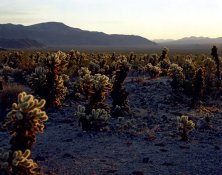JeffD
Member
Admittedly, I have only photographed a little in the beautiful desert landscapes. I came across this site with some great pics of backlit cactus in Joshua Tree.
Take a look at the very first cactus picture at the top of this page:
http://www.joshuatreenationalpark.net/cholla.htm
Imagine you, as a zone system exposure practitioner, were metering this scene. You have a massive brightness scale, considering the darkest shadows, when compared to the sun coming over the far ridge- the author says maybe about 12 stops.
What would be your actual thought process metering this scene here? expose for the shadows? How will you pull in the highlights, that seem almost un retrievable through contracted developing? Would you reach for a graduated neutral density filter? What calculations are going through your mind? What must you do to make the shot a success in your mind?
For the sake of discussion, lets assume you are shooting black and white, and doing your own processing.
The reason I ask, is that I might be in a similar environment, in about a week. I'll have my 4x5, a 90mm, 150mm, 210mm and 300mm lenses. I'll have most filters common to black and white, and nd grads as well. I'll be shooting Ilford fp4+, probably processing in Rodinal 1:50, which I think I have pretty good control over.
I have an idea of how I might approach something like this, but would like to maximize my success. Of course, I'll need your help to pull it off!
Any comments appreciated!
Take a look at the very first cactus picture at the top of this page:
http://www.joshuatreenationalpark.net/cholla.htm
Imagine you, as a zone system exposure practitioner, were metering this scene. You have a massive brightness scale, considering the darkest shadows, when compared to the sun coming over the far ridge- the author says maybe about 12 stops.
What would be your actual thought process metering this scene here? expose for the shadows? How will you pull in the highlights, that seem almost un retrievable through contracted developing? Would you reach for a graduated neutral density filter? What calculations are going through your mind? What must you do to make the shot a success in your mind?
For the sake of discussion, lets assume you are shooting black and white, and doing your own processing.
The reason I ask, is that I might be in a similar environment, in about a week. I'll have my 4x5, a 90mm, 150mm, 210mm and 300mm lenses. I'll have most filters common to black and white, and nd grads as well. I'll be shooting Ilford fp4+, probably processing in Rodinal 1:50, which I think I have pretty good control over.
I have an idea of how I might approach something like this, but would like to maximize my success. Of course, I'll need your help to pull it off!
Any comments appreciated!




